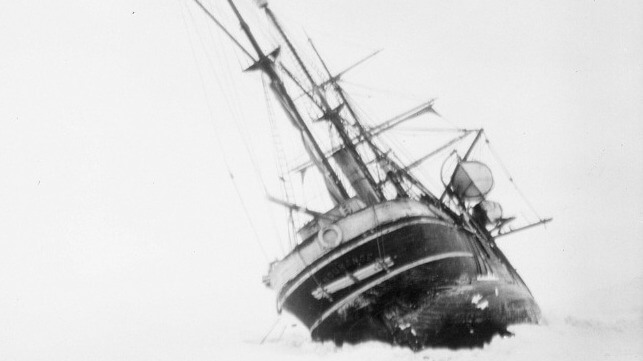Shackleton's Ship May Have Sunk Because of Weak Internal Framing

Sir Ernest Shackleton's famed ship, the Endurance, may have gone down because of inadequate internal framing, according to a new study by Finnish researchers.
Endurance was a three-masted barque constructed in 1912 at a yard in Norway. She was built for tourist-oriented hunting expeditions in icy Arctic waters, with thick planking and double framing of oak and fir. Her bow was more than 50 inches thick.
While heavily built by comparison to everyday ships, as has been much-discussed in historical accounts, Endurance was not designed for operations in thick pack ice. Roald Amundsen's vessel, the Fram, had a canoe hull that was intended to rise up under ice pressure, not to get sandwiched and crushed; Endurance's crew found that their ship's hull shape was more liable to getting stuck. According to the new study, her internal bracing was also less sturdy than Fram's, particularly in way of the engine room. The hull design had not been conceived to resist heavy horizontal pressure for months at a time, as occurs when trapped in pack ice, and her engine room was larger and more open than other polar ships.
Shackleton bought her in 1914, and understood at the time that "this ship is not as strong" as the Nimrod, the vessel he had used on a previous expedition. He had an understanding of how to refit a vessel with the internal beams needed to resist heavy ice pressure, having done so before. For reasons unknown to history, perhaps due to personal and financial circumstances, he did not do so before setting sail later that year.
Endurance was caught in ice in the Weddell Sea in late January 1915, and she drifted in the pack until October. One crewmember recorded that the worst of the ice pressure appeared to be concentrated in the area of the engine room, little reinforced and vulnerable. On October 24, heavy pressure waves in the ice pack broke off the rudder and crushed the stern, resulting in flooding; Shackleton ordered the crew to abandon ship on October 27, and the vessel finally sank below on November 21.
"The weakest part of its hull was the engine room area, which was not only larger than in other early Antarctic ships but also lacked beams to give strength against compression by ice. Comparison with other wooden polar ships is not favorable for Endurance: ships designed for compressive pack ice were stronger," concluded Jukka Tuhkuri, a naval architect and researcher who has joined previous expeditions to the wreck site. "While the final reason was tearing off the keel, Endurance sank because the vessel was simply crushed in compression by ice."
